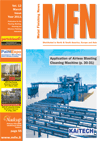E-Archive
Good Vibrations
in Vol. 12 - March Issue - Year 2011
Faster Finishing: High Speed Vibratory Mass Finishing Shorter Process Times/High Material Removal

Faster finishing

The high speed rotary vibrator (HS)

The high speed rotary vibratory (HS) machine was developed for forged aero-engine turbine blades

Reduced process times and high material removal are the expectations and preferences of most users of vibratory mass finishing machines. As a result of a close co-operation with a leading aero-engine turbine blade manufacturer a new type of rotary vibratory machine has been born.
A recent development in equipment design has lead to a unique high speed (HS) vibratory finishing machine that reduces process times when compared with any conventional rotary vibratory machine.
German engineers have designed and built a machine that at first glance looks like a standard rotary vibratory machine but hidden inside the specially reinforced stressed relieved structure is a high speed high energy 12.5Kw/17Hp motor, additional heavy duty coil springs are installed to support the extra weight of the strategically reinforced process chamber, as the machine lining is subjected to additional abrasion an extra thick adiprene polyurethane wear resistant lining ensures a long life.
The relatively faster uniformed rotational movement and increased speed of the media/component mass and very precise control of the high amplitude is the key to the considerably reduced process times.
As with all vibratory finishing techniques it is the finishing process that is the driver behind every new equipment development, the high speed (HS) vibratory machine was no exception. A leading manufacturer of forged aero-engine turbine blades was looking for a faster and economical method to improve their existing vibratory finishing process. The components in question were forged titanium and nickel-alloy blades and vanes that required a lot of material removal in order to achieve smooth surfaces on the airfoils.
The customer considered some of the existing types of equipment that are already proven to be faster than conventional vibratory finishing such as the centrifugal disc finishing machine. It is a known fact that process times in this type of machine can be at least 15 - 20 times faster when compared to conventional vibratory finishing, but in this case some of the turbine blades were long (over 10" 250mm) and the quantities to be finished very high ruling out this type of machine. The customer preferred an automated system with little or no labour input so a high speed barrel and conventional drag finishing machines were also not suitable. Some improvement to the customer’s existing process was achieved by developing a new ceramic media, the process time was reduced slightly but this was still not enough for the customer. In order for him to keep up with an ever increasing demand for more throughput it was looking like he would have to purchase many more machines similar to his existing design but this was a huge problem as they had no more physical space to expand. Designing a new high speed (HS) vibratory machine was the only answer.
The new high speed (HS) rotary machines have now been in operation at the turbine blade manufacturer for over 2 years so it is safe to say that this type of machine now has its place in the proven types of finishing equipment available in the market today.
The high speed (HS) machine has many applications outside of the aerospace industry. If the volumes to be finished are large and the shortest possible process time is required then this technique is applicable and should be considered.
I was asked if there is a downside to using the HS machine compared to the conventional rotary vibratory machine. The consumption of media is higher and this may be considered a disadvantage by some, however it is relative as the process time is considerably shorter.
When the process running costs have been compared it is actually more beneficial to use the High Speed machine as a much greater production throughput is achieved. The machine is generally more expensive to purchase than a conventional rotary vibratory machine but much less than a centrifugal disc or drag type machine, and unlike these machines the quantities of components that can be finished per batch are considerably higher. All things considered this type of machine is unparalleled for economic fast finishing of mass produced components.
Good Vibrations
by Paul Rawlinson
Contributing Editor MFN & Business Development Manager, Aerospace International for Rösler
Tel. +49.9533.924 647
Fax +49.9533.924 601
E-mail: P.Rawlinson@rosler.com




























